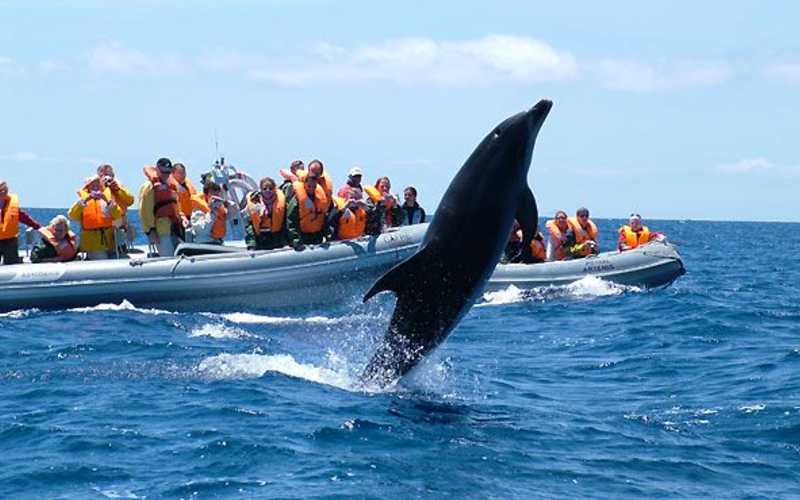If you are looking for an exciting Whale watching experience in the Atlantic Ocean, then Azores is definitely the place to be. There are a wide variety of species and plenty of ports that offer Whale watching cruises.
Whale Watching in the Azores – Where to go
The most popular spots for Whale watching in the Azores are Vila Franca do Campo and Ponta Delgada. You can book these trips with Get Your Guide and Viator, or book with a local guide on arrival.
Dolphins in the Azores
Although most whale watching trips focus on dolphins, divers and snorkelers also find rare glimpses of sperm whales in the Azores region. Some Azorean islands have resident populations of sperm whales; these can be seen by diving groups or snorkelers exploring underwater caves.
Since most of these dolphins are transient, it’s hard to know how many species there are in the Azores region. It is known that these cetaceans have different strategies for hunting and avoiding their predators. Some populations of Risso’s dolphins live in tropical or sub-tropical waters, the same habitat as many other dolphin species. In the Azores, they spend much of their time in less tropical waters.
What Species of Whale to Look for in the Azores
Once you are familiar with the species common to the Azores, it will be much easier to find them on an expedition. The most common whale seen on whale watching tours in the Azores is the sperm whale.
There are four whales you can spot while sailing off the coast of the Azores, and now you know what to look for! Some of the most common whales seen on whale watching tours in this enchanting region are sperm whales. Following a knowledgeable Azores whale-watching guide will help make your trip more fun and fruitful.
Sperm whales are the most commonly seen whale in the Azores region. This is partly due to their size and their penchant for diving so deep that they are often out of sight of whale watching boats. The largest of the toothed whales, they can measure up to 60 feet in length and weigh as much as fifty tons. Mature males have a dozen or more teeth that can measure up to three feet long!
These gentle giants feast on squid, but will also eat octopus, shrimp, fish and crab. Females give birth to a calf once every three to four years after a year-long gestation period. Calves nurse for about one year before being weaned at about two years old.
While calf/mother pairings are quite common, adult males are often found alone. Perhaps this is because competition for a mate is stiff among sperm whales! Males battle one another for females in head-to-head duels over several days, swimming at the surface and slapping their huge tails against the water.
The second-most commonly seen whale in the Azores region is the beaked whale. These elusive creatures are rarely seen, but their unmistakable spout and other markings make them easy to identify. Beaked whales spend a lot of time in deep water, so you may not see one on your Azores whale watching tour, but it’s fun to know they’re out there!
This species of whale is difficult to study because it is so elusive and spends much of its time in deep water. Scientists know that they find food by using low frequency sounds that cannot be heard by humans, which they use for echolocation. They also communicate with one another using these same noises.
The third whale you might see on an Azores whale watching tour is the Risso’s dolphin. Named after a 19th-century French explorer, this tubby, black-and-white creature is often seen in pods of small numbers. These characters love to play and splash; they are not shy and will approach and even interact with your boat!
The last whale you may see while on an Azores whale watching tour is the blue whale. This enormous creature is nearly as large as all the whales combined! It is also among the most mysterious of whales: Scientists have received conflicting reports about this species’ status and numbers worldwide.
It’s possible that blue whales are more widely distributed than is currently believed. The species has been sighted in off shore areas, and some studies have shown they prefer to travel alone or in small groups. However, many scientists have found that blue whales seem to travel in larger groups when they migrate north into colder waters.
Whatever the case, the Azores are a wonderful place to hop aboard a whale watching boat and see what whales you can spot! You know what to expect and who you might see out there, so prepare for an exciting adventure!
If you enjoyed this article you might also like to read about Terceira Azores Island



1 thought on “Whale Watching Azores”